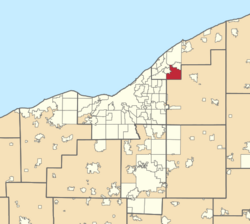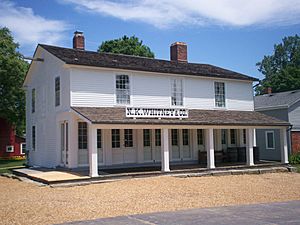Kirtland, Ohio facts for kids
Quick facts for kids
Kirtland, Ohio
|
|
|---|---|

|
|
| Motto(s):
"City of Faith & Beauty"
|
|

Location of Kirtland in Greater Cleveland
|
|
| Country | United States |
| State | Ohio |
| County | Lake |
| Area | |
| • Total | 16.80 sq mi (43.52 km2) |
| • Land | 16.67 sq mi (43.18 km2) |
| • Water | 0.13 sq mi (0.34 km2) |
| Elevation | 1,037 ft (316 m) |
| Population
(2020)
|
|
| • Total | 6,937 |
| • Density | 416.11/sq mi (160.66/km2) |
| Time zone | UTC-5 (Eastern (EST)) |
| • Summer (DST) | UTC-4 (EDT) |
| ZIP code |
44094
|
| Area code(s) | 440 |
| FIPS code | 39-40642 |
| GNIS feature ID | 1086419 |
Kirtland is a city in Lake County, Ohio, United States. In 2020, about 6,937 people lived there. Kirtland is famous for being an important place for the Latter Day Saint movement from 1831 to 1837. It's where they built their first temple, the Kirtland Temple, which was finished in 1836.
Today, the Kirtland Temple and the nearby Historic Kirtland Village are special places that show what life was like back then. The city also has many parks that are part of the Lake Metroparks system, and it's home to the Holden Arboretum, a huge garden and nature preserve.
Contents
History of Kirtland
After the United States was founded, the northern part of Ohio was called the Western Reserve. This land was sold to a group called the Connecticut Land Company. The area where Kirtland is now was first explored by Moses Cleaveland and his team in 1796.
How Kirtland Got Its Name
Kirtland is named after Turhand Kirtland. He was an important person in the Connecticut Land Company and a judge. Turhand Kirtland was known for being fair and brave, especially in his dealings with local Native Americans.
His son, Dr. Jared Potter Kirtland, also made a name for himself. He helped start a medical college nearby. He also wrote the first book about the birds of Ohio. A rare bird, the Kirtland's warbler, is named after Jared Kirtland. This bird has been seen in the city during its migration, but it doesn't build nests there.
Early Settlers and Growth
Kirtland's land was covered in thick forests and had clay soil, making it harder to settle than other nearby areas. The first European settlers in Kirtland were the John Moore family, followed by the Crary family in 1811. Christopher Crary later wrote about his life in Kirtland, giving us many details about the early days.
Kirtland as a Religious Center
From 1831 to 1838, Kirtland was a very important place for the Latter Day Saint movement. Their leader, Joseph Smith, moved the church to Kirtland in 1831.
In Kirtland, the Latter Day Saints built their first temple, the Kirtland Temple. Even though the area was still developing and many church members were not rich, the temple was built beautifully. Many people who attended the temple's dedication in 1836 said they saw amazing heavenly visions. Because of this, Kirtland is still a very special place for all groups within the Latter Day Saint movement. Many important teachings of the church were written in Kirtland during the 1830s.
For a long time, the Community of Christ church owned the Kirtland Temple. They gave tours and allowed others to use it. However, in March 2024, ownership of the temple and other historic sites was transferred to The Church of Jesus Christ of Latter-day Saints (LDS Church).
Kirtland from 1838 to Today
After most of the Latter Day Saints left Kirtland in 1837–38, the city's population became smaller. Life in Kirtland was typical for the region. Most of the wooded areas were cleared for farming, with corn and apples being the main crops.
In the early 1900s, Kirtland School was built. This school brought together students from three smaller school houses. One of the old school houses can still be seen in Kirtland Hills. Kirtland didn't change much until after World War II. Then, new neighborhoods were built, and more schools were added in the 1950s and 60s.
The 1960s also saw more local businesses open. A shopping center was built, bringing many stores and services together. When Interstate 90 opened in 1965, it made it much faster to travel to Cleveland. In 1968, the people of Kirtland voted to make their township an official village. Kirtland became a city in 1970 when its population grew to over 5,000 people.
The LDS Church bought the N.K. Whitney Store in 1979 and restored it in 1984. It became a historic site where people could take tours. The Whitney home, across the street, was also acquired and used as a visitor center.
By the late 1990s, Kirtland was becoming a popular place for tourists. So, in 2000, the Historic Kirtland Village was created. This village shows what life was like in the 1830s when important figures like Joseph Smith and Brigham Young lived there. The project included restoring the Whitney home and building new, accurate copies of old buildings like an inn, schoolhouse, and sawmill. A new visitor center was also built. The village was completed in 2003. In 2023, the church also finished restoring the Joseph and Emma Smith home.
Kirtland still has some active farms, including cattle and horse farms. Some people also make maple syrup from the trees. Kirtland has even been visited by two sitting Presidents of the United States, including George W. Bush.
Geography and Nature
Kirtland covers about 16.80 square miles (43.51 km2) of land and water. Most of this is land, about 16.67 square miles (43.18 km2).
The city is located south of Lake Erie and sits on higher ground in the Allegheny Plateau. Important natural features include the East Branch of the Chagrin River, Pierson's Knob, and Gildersleeve Mountain, which is about 1,163 feet (354 m) high. Daniel's Mountain, at 1,246 feet (380 m), is the highest point.
The forests in Kirtland are mostly northern hardwood forests, with trees like hemlock, beech, and maple. Some older oak and hickory forests can also be found.
Kirtland is in the "snowbelt" region near Lake Erie, so it gets a lot of snow, similar to nearby Chardon. The average snowfall is over 100 inches (250 cm) per year, and some areas can get over 250 inches (640 cm) in a season!
Kirtland is mainly a place where people live. Over 20% of the land is preserved as forest or park land. The Holden Arboretum is the largest of these, covering 3,500 acres (14 km2), though not all of it is in Kirtland. There are also three metropolitan parks in Kirtland: Chapin State Forest, Penitentiary Glen, and Lake Farm Park. Lakeland Community College is also largely located in Kirtland.
Population and People
| Historical population | |||
|---|---|---|---|
| Census | Pop. | %± | |
| 1880 | 206 | — | |
| 1970 | 5,530 | — | |
| 1980 | 5,969 | 7.9% | |
| 1990 | 5,881 | −1.5% | |
| 2000 | 6,670 | 13.4% | |
| 2010 | 6,866 | 2.9% | |
| 2020 | 6,937 | 1.0% | |
| U.S. Decennial Census | |||
In 2010, there were 6,866 people living in Kirtland. Most people (97.7%) were White. About 1.1% of the population was Hispanic or Latino.
The average age in Kirtland was 46.9 years. About 23% of the people were under 18 years old, and 19.1% were 65 or older. Most households (66.3%) were married couples living together.
Many people in Kirtland are well-educated. In 2010, about 39.4% of adults over 25 had a bachelor's degree or higher. In 2018, the main languages spoken were English (92.5%), Croatian (2.2%), Italian (1.5%), and Slovene (1.5%).
Notable People from Kirtland
- Alma M. Aldrich, a member of the Wisconsin State Assembly, was born in Kirtland in 1837.
- Elizabeth Watson Russell Lord, an educator and helper of others, lived in Kirtland from 1819 to 1847.
- Hattie Martindale, who became famous by accident, was born in Kirtland in 1838.
- Emma Smith, the wife of Latter Day Saint movement founder Joseph Smith, lived in Kirtland for several years in the 1830s.
- Joseph Smith, the founder and leader of the Latter Day Saint movement, lived in Kirtland from 1831 to 1832 and from 1833 to 1838.
- Newel K. Whitney, an early leader of the Latter Day Saint movement, lived in Kirtland from 1819 to 1838.
- Brigham Young, who became the second president of The Church of Jesus Christ of Latter-day Saints, lived in Kirtland from 1833 to 1837.
Images for kids
See also
 In Spanish: Kirtland (Ohio) para niños
In Spanish: Kirtland (Ohio) para niños







